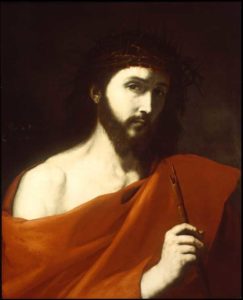Object of the Month: August 2014
Ecce Homo (Behold the Man)
Oil on canvas, Signed and dated middle left: Jusepe de Ribera español/ F.1638
Jusepe de Ribera, called Lo Spagnoletto
Spanish, active in Naples, 1591-1652
Ribera was born in Javita, Spain and presumably apprenticed in his homeland until he sailed for Naples, Italy in 1607, where he first observed the works of Caravaggio and developed an early affinity for the master’s style. Caravaggio’s art was a continual influence throughout Ribera’s career, but a trip to Rome provided exposure to the classical style of the Carracci and Guido Reni. Ribera’s impressive list of collectors includes Cosimo II, the Viceroys of Naples, and King Philip IV. He always considered himself a Spaniard (hence, the identification in the present signature) and greatly influenced the art of his homeland although he lived in Italy most of his life and made a considerable impact on Italian Baroque artists.
The present Ecce Homo is a devotional picture boldly presenting Christ after his torture and mockery by the Roman soldiers. Ribera painted the work in 1638 at the height of his popularity, and it illustrates his ability to combine a strong spiritual image with poignant realism. Christ gazes at the viewer with a confidence amidst the mockery, knowing that the crown of thorns and reed-scepter are emblems of a heavenly power unrealized by mankind. The empty background, isolation from the jeering crowd, and the engaging look of Christ’s eyes all contribute to create an arrestingly moving portrait of the highest order.
“El Greco to Goya” is the earliest known exhibition in which this painting participated—a 1963 show held at the John Herron Museum of Art in Indianapolis, IN and at the Museum of Art, Rhode Island School of Design in Providence, Rhode Island. Additionally, the Kimbell Art Museum in Fort Worth, TX hosted an exhibit in 1983 including M&G’s Ribera. Two of the foremost American scholars on Spanish paintings, Craig Felton and William Jordan, produced a corresponding exhibition catalog in which M&G’s painting is referred to as “unquestionably the finest” of Ribera’s known works of this subject.
John M. Nolan, Curator
Published in 2014
